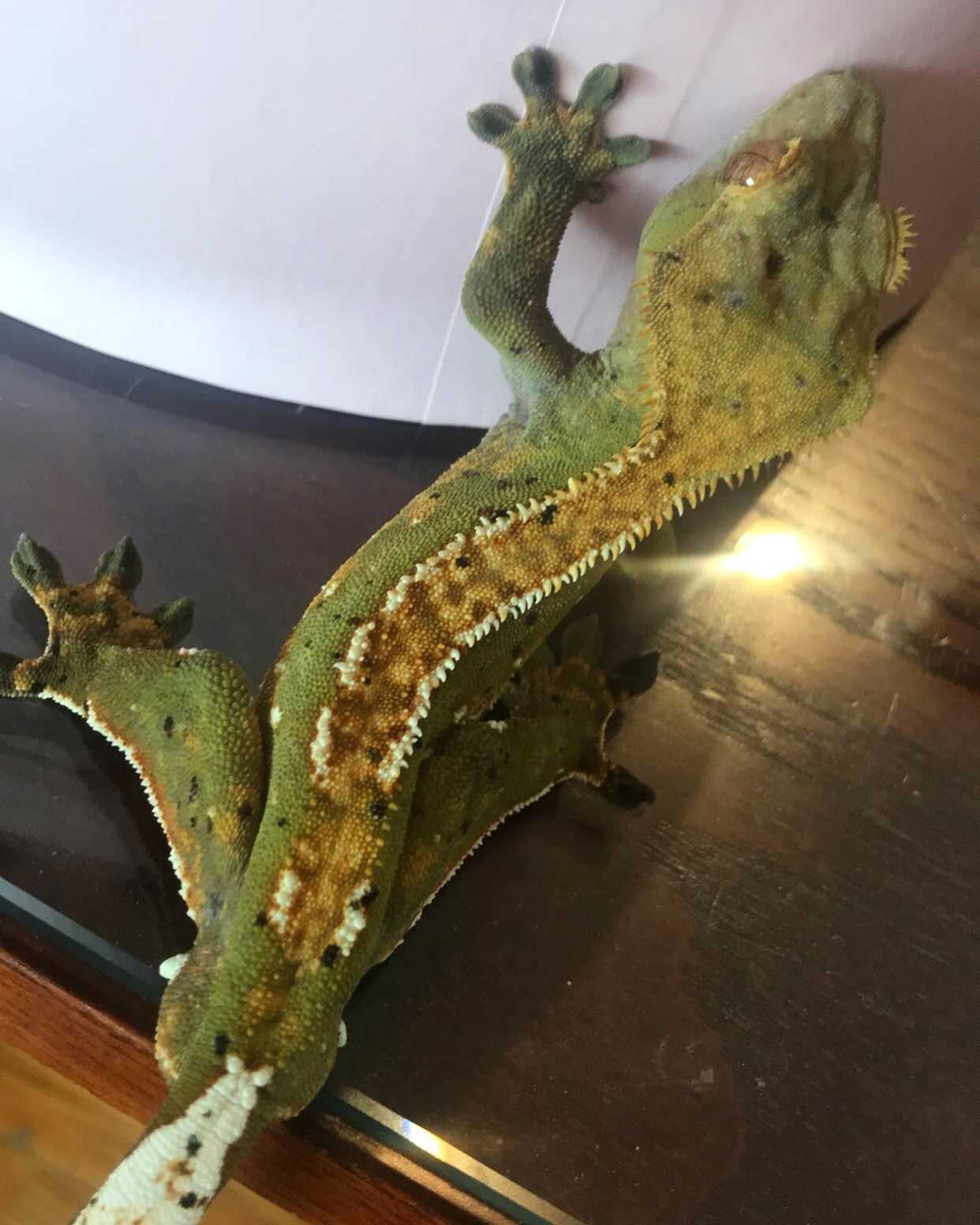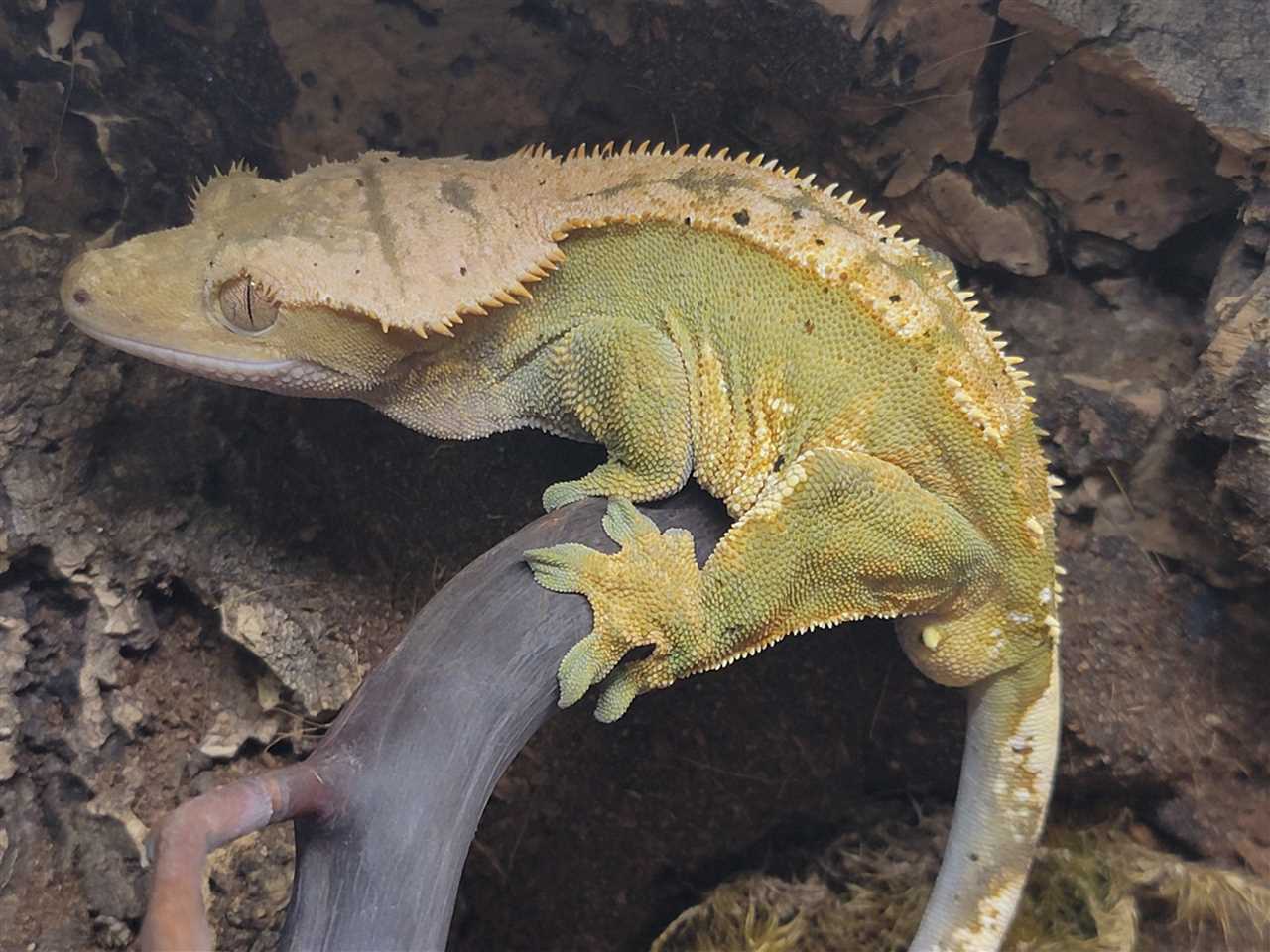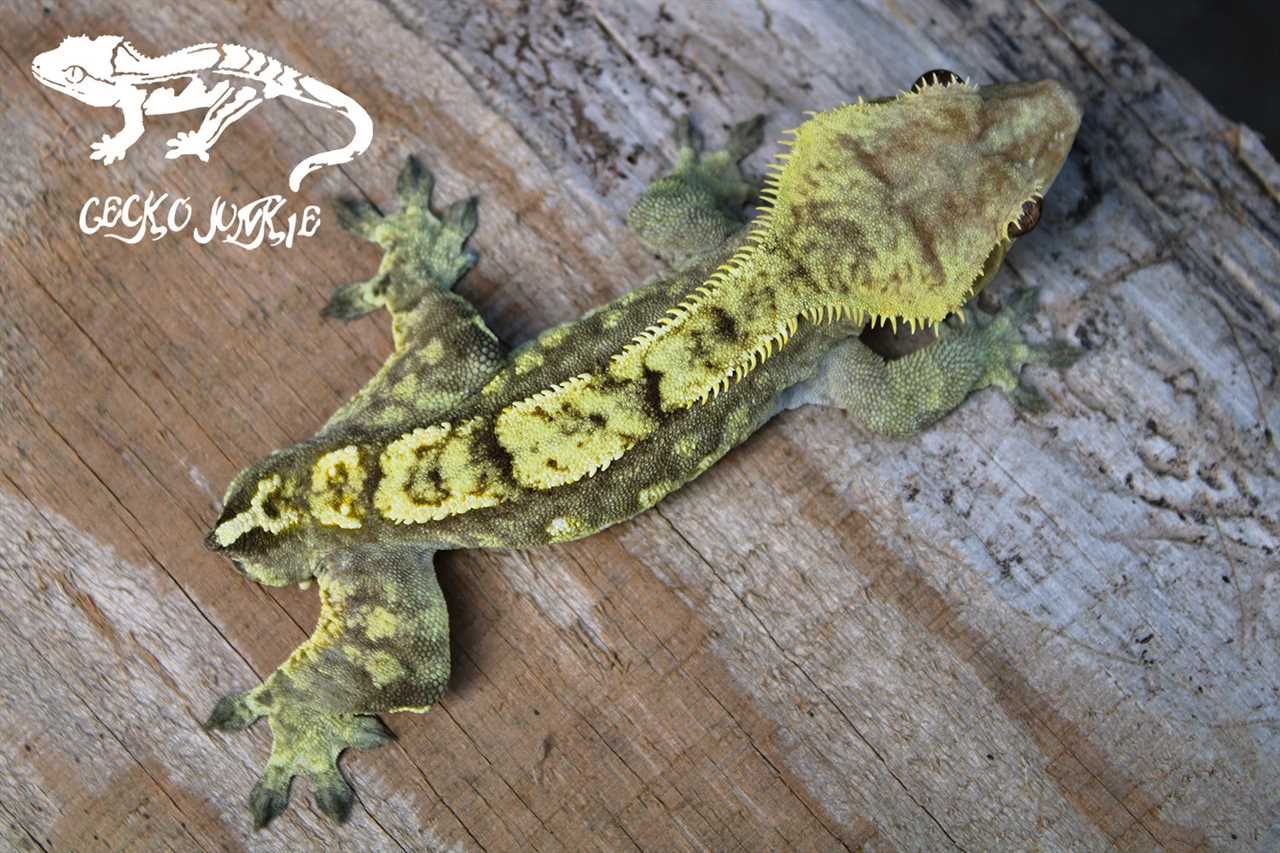One of the most interesting things about the green crested gecko is its ability to change its color. Depending on its mood and environment, this reptile can exhibit a wide range of colors, from bright green to dark brown. It’s like having a chameleon as a pet! This color-changing ability is not only captivating to watch, but it also serves as a natural camouflage, helping the gecko blend into its surroundings.
Did you know? The green crested gecko is native to New Caledonia, a group of islands located in the southwestern Pacific Ocean. This lizard is a popular choice among reptile enthusiasts due to its unique appearance and relatively easy care requirements.
What is a Green Crested Gecko?
Habitat for a Green Crested Gecko

1. Enclosure Size
2. Substrate
For the substrate, it is best to use a combination of coconut fiber and sphagnum moss. This will create a natural and moisture-retaining substrate, mimicking the damp forest floor of their natural habitat.
3. Lighting
Green crested geckos are primarily nocturnal, so they do not require UVB lighting. However, it is still important to provide some form of lighting to help regulate their day and night cycles. A low-wattage incandescent bulb or a reptile-specific nocturnal heat lamp can be used.
4. Temperature and Humidity

Maintaining the proper temperature and humidity levels is crucial for the health of your green crested gecko. The temperature should be kept between 72-78°F (22-26°C) during the day and can drop slightly at night. Keep in mind that providing a temperature gradient within the enclosure is important, so the gecko can choose the most comfortable spots.
The humidity should be maintained at around 60-70%, with occasional misting throughout the day. This can be achieved by using a hygrometer to monitor the humidity levels and misting the enclosure with water as needed.
5. Decorations
Adding various climbing branches and foliage to the enclosure will not only create a visually appealing habitat but also provide ample hiding spots and climbing opportunities for your green crested gecko. Live plants, such as pothos or bromeliads, can also be added to help maintain humidity levels and create a more natural environment.
Additionally, providing a shallow water dish for drinking and gently misting the enclosure with water will help ensure your green crested gecko stays hydrated.
Remember to regularly clean and maintain the enclosure to prevent the buildup of bacteria and fungus, which can lead to health issues for your gecko.
By following these habitat guidelines, you can create a comfortable and stimulating environment for your green crested gecko, allowing them to thrive as a colorful and fascinating pet.
Temperature and Humidity Requirements
The Diet and Feeding Habits of Green Crested Geckos
What do Green Crested Geckos Eat?
In the wild, green crested geckos primarily feed on a variety of insects, including crickets, roaches, and fruit flies. As pets, a diet consisting of live insects is recommended for their overall health. However, it’s essential to provide a balanced diet by introducing a variety of insects to their diet.
Some popular feeder insects for green crested geckos include:
- Crickets
- Roaches
- Dubia roaches
- Fruit flies
- Mealworms
- Waxworms
Supplementing their Diet
While live insects should make up the majority of a green crested gecko’s diet, it’s also important to supplement their diet to meet their nutritional needs. This can be done by dusting the insects with a calcium or vitamin powder supplement. The frequency of supplementation will depend on your gecko’s age and individual needs.
Feeding Schedule
Green crested geckos are nocturnal animals, meaning they are most active during the night. Therefore, it’s best to feed them in the evening or early morning when they are most active and hungry. Feeding them around this time will also mimic their natural feeding behavior in the wild.
It’s recommended to offer food every 2-3 days to adult crested geckos, while younger geckos might require daily feedings to support their growth and development. Observe your gecko’s behavior and adjust the feeding schedule accordingly to ensure they are getting enough food without overfeeding.
Overall, a well-rounded diet consisting of live insects and proper supplementation is the key to maintaining the health and longevity of your green crested gecko. Pay attention to their feeding habits, provide a varied diet, and offer fresh water, and you will have a happy and healthy gecko as your tropical pet!
Handling and Socialization
Before attempting to handle your Green Crested Gecko, it’s crucial to create a comfortable and secure environment for them. This includes providing a suitable habitat with the right temperature and humidity levels, as well as plenty of hiding spots and climbing opportunities.
Socialization is also an important aspect of caring for a Green Crested Gecko. While they may not be as social as some other pets, they can still benefit from regular interaction and stimulation. Spend time near their enclosure, talking to them softly or offering them treats to establish trust and familiarity.
Overall, handling and socializing a Green Crested Gecko can be a rewarding experience for both the owner and the pet. By creating a comfortable environment and approaching them with patience and care, you can build a positive relationship with your colorful and fascinating reptile companion.
Common Health Issues of Green Crested Geckos
Metabolic Bone Disease
Metabolic bone disease is a common health issue in green crested geckos. It occurs due to a lack of calcium and/or vitamin D3 in their diet. This disease can result in weak and brittle bones, leading to deformities, difficulty in climbing, and even fractures. To prevent metabolic bone disease, ensure that your gecko’s diet includes calcium-rich foods and that they are exposed to proper UVB lighting to aid in vitamin D3 synthesis.
Respiratory Infections
Respiratory infections can affect green crested geckos if they are kept in improper temperature and humidity conditions. These infections can cause symptoms such as wheezing, difficulty breathing, nasal discharge, and lethargy. Providing the right environmental conditions, including optimal temperatures and humidity levels, is essential to prevent respiratory infections. Regularly clean and disinfect the enclosure to minimize the risk of bacterial or fungal growth.
Parasites
Mouth Infections
Mouth infections, such as stomatitis, can occur in green crested geckos. This condition is characterized by inflammation and infection of the mouth, gums, and oral cavity. It can be caused by poor dental hygiene, injuries, or bacterial and fungal infections. Signs of mouth infections in geckos include drooling, difficulty eating, and swelling around the mouth. Regularly check your gecko’s mouth for any abnormalities and maintain proper oral hygiene to prevent mouth infections.
Conclusion
While green crested geckos are generally healthy reptiles, they can still be susceptible to various health issues. Metabolic bone disease, respiratory infections, parasites, and mouth infections are among the common health problems that can affect these adorable pets. By providing a balanced diet, proper environmental conditions, and regular veterinary check-ups, you can help ensure the overall well-being and longevity of your green crested gecko.
Handling and Safety Tips
1. Approach with Caution
Always approach your gecko with caution and gentleness. Sudden movements or aggressive handling can cause stress and injury to your pet.
2. Support the Body
3. Be Mindful of Temperature
4. Wash Your Hands
Before and after handling your gecko, make sure to wash your hands thoroughly with soap and warm water. This helps to prevent the spread of any infectious diseases.
5. Avoid Overhandling
While handling your gecko is important for socialization, it’s crucial not to overdo it. Green Crested Geckos are nocturnal creatures and prefer to be left alone during the day. Limit handling to short periods of time and let them rest in their enclosure.
6. Create a Safe Handling Area
Whenever you handle your gecko, make sure you have a safe and controlled area for them to explore. This can be a small table or a hand-held container lined with soft substrate to prevent injuries from falls.
7. Be Aware of Escape Risks
8. Respect Boundaries
Every gecko has its own tolerance level for handling. Pay attention to their body language and behavior, and respect their boundaries. If they show signs of stress or discomfort, it’s best to put them back in their enclosure.
By following these handling and safety tips, you can ensure a positive and safe interaction with your pet Green Crested Gecko.
Enclosure Setup and Decorations for a Green Crested Gecko
Habitat Requirements
Before setting up the enclosure, make sure you have a well-ventilated terrarium or vivarium that is at least 20 gallons in size. This will provide enough space for your gecko to climb and explore.
As nocturnal animals, green crested geckos prefer low light levels. You’ll need to provide a heat source, such as an under-tank heater or heat lamp, to maintain a temperature between 72-82°F (22-28°C) during the day and 65-75°F (18-24°C) at night. A digital thermometer will help you monitor the temperature accurately.
Humidity is also essential for the health of your gecko. Maintain a humidity level between 60-80% by misting the enclosure with water once or twice a day. You can also use a hygrometer to keep track of the humidity levels.
Enclosure Decorations

To create a natural and enriching environment for your green crested gecko, add various decorations and hiding spots in the enclosure. Here are some ideas:
- Branches and vines: The gecko loves to climb, so provide sturdy branches and vines for them to explore.
- Plants: Live or artificial plants will not only make the enclosure look more appealing but also provide hiding spots for your gecko.
- Hiding spots: Add hollow logs, bark, or coconut hides for your gecko to retreat to during the day.
- Substrate: Use a substrate such as coconut fiber or reptile carpet, which can also help maintain humidity levels.
- Water dish: Place a shallow water dish that is easily accessible for your gecko to drink from.
By providing a suitable enclosure setup with the right décor, you can create a comfortable and stimulating environment for your green crested gecko to thrive in.
Breeding and Reproduction
Green crested geckos reach sexual maturity at around 1-2 years of age. Once they are ready to breed, it is essential to introduce the male and female geckos in a separate enclosure to prevent any aggressive behavior. It is recommended to introduce them in the evening when they are more active.
Breeding green crested geckos can be a fascinating and rewarding experience for reptile enthusiasts. By following the proper breeding and care guidelines, individuals can contribute to the conservation and preservation of these beautiful lizards.
Growth and Development of a Green Crested Gecko
Proper nutrition plays a crucial role in the growth and development of a Green Crested Gecko. These reptiles are primarily insectivores, feeding on a diet consisting of various insects, such as crickets and fruit flies. It’s essential to provide them with a balanced diet that includes a variety of prey items to ensure they receive all the necessary nutrients for healthy growth.
Green Crested Geckos reach sexual maturity at around 12 to 18 months of age. Males typically have larger crests and may display more vibrant colors to attract potential mates. Breeding and reproduction can be a rewarding experience for hobbyists, but it requires careful planning and a suitable breeding setup.
Overall, observing the growth and development of a Green Crested Gecko is a fascinating journey. Their vibrant colors, unique crests, and gradual transformation make them an enchanting pet reptile. By providing them with a suitable habitat, a balanced diet, and proper care, you can ensure that your Green Crested Gecko thrives and reaches its full potential.
Growth and Development of the Green Crested Gecko
During the first few weeks, the gecko will primarily feed on small insects and fruit puree. As it grows, its diet will transition to mostly fruit and prepared gecko diet. It is crucial to provide a balanced diet that includes calcium and vitamin supplements to support their bone and muscle development.
It takes about one to two years for the green crested gecko to reach its full adult size, which is typically around 6 to 8 inches long. Proper nutrition, temperature, and humidity play a significant role in their growth. Regularly monitoring their weight and size can help identify any potential health issues.
Overall, providing a suitable environment, a balanced diet, and regular monitoring are essential for the healthy growth and development of green crested geckos. These beautiful reptiles can be a fascinating pet for anyone interested in exotic animals.

I’m Lena Adams—a product of an unconventional upbringing in the African wilderness. My father, a daring explorer of African wildlife, sparked my fascination with reptiles, a passion that intertwined with the tragic loss of my mother during an expedition, leaving an indelible mark on my life. Driven to understand the creatures that captivated my parents, I embarked on my journey, sharing insights about reptiles, frogs, and lizards on my website. Through my explorations and conservation efforts, I honour my family’s legacy while seeking connections—to the creatures, nature, and the mother whose presence I yearn to understand.
